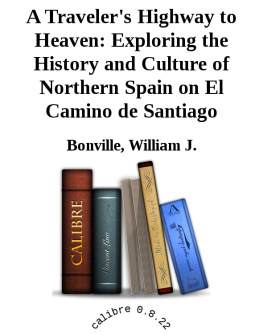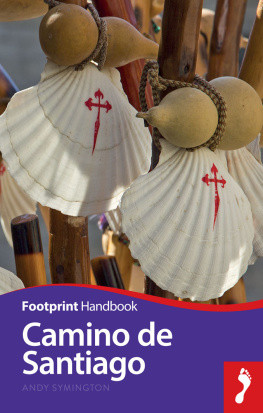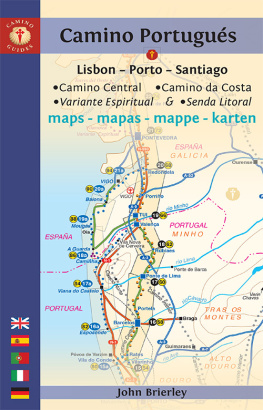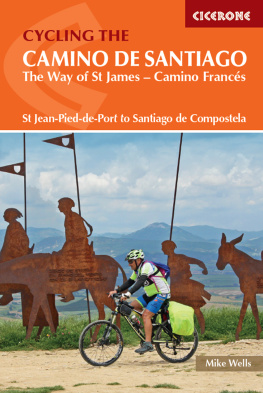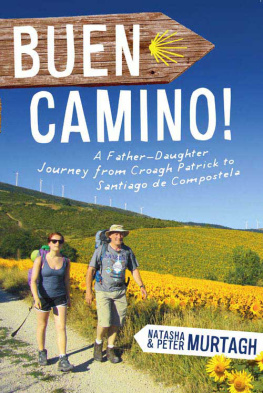A Travelers Highway
to Heaven
History on the Hoof
Exploring the History and Culture
of Northern Spain on El Camino de Santiago
by
William J. Bonville
Cover photo - Cathedral of St. James at Santiago de Compostela, by A. Korzekwa
Cover art by William Jesse Griffith www.tivmonkey.com
Copyright 2007 by William J. Bonville
All Rights Reserved
Published by SynergEbooks
http://www.synergebooks.com
-
PREFACE
This book is intended for travelers with a taste for history and an interest in how the things they see got to be the way they are.
What this is about is an exploration of what some call the Highway to Heaven. These pages describe a motor-walking junket that courses that highway through Northern Spain, end to end.
I call it history on the hoof.
The itinerary is designed for the time-limited working person taking a three-week vacation using a rental car and shanks mare. It is intended to make the most of a unique vacation opportunity, and treats time, historical import and see-worthiness as the principal factors for making decisions on where to go and what to see.
The author went there, did that and came home, just as described, verifying it could be done as advertised. Moreover, he had a wife with him who made sure it was done enjoyably without hectic dashing around and sacrifice of creature comforts.
A detailed itinerary, to be used as a model for your personal planning purposes, is presented at the back of the book. That itinerary follows the travel sequence covered in the pages which follow.
Would a longer trip be worthwhile? Are there other things to see?
You bet.
Can you modify that itinerary to suit your own taste?
Be my guest. It also adapts to the needs and whims of free spenders or folks on a budget. Back pack it or make it a luxurious grand tour.
Can it be adapted for someone only able to allow two weeks for the trip? Certainly, better just two weeks than nothing at all. Simply review the book, decide what you think is appropriate to
skip or cut short, and plan accordingly. Suggestions are given at the end of the listed itinerary.
Been there and done that?
Read on and find out what you missed seeing or knowing about what you saw.
Finally, since this history deals with a cultural milieu unfamiliar for many travelers, a glossary is also appended to the book. It clarifies repetitive uses of terminology peculiar to the region and its history, and brief summaries of detailed descriptions provided but once in the text where applicable, but not repeated where the terms are used elsewhere.
-
INTRODUCTION
Our destination is set in Northern Spain. There we travel a very special route: the historic pilgrimage road, El Camino de Santiago, The Way of St. James.
For the faithful it is a Highway to Heaven. For anyone else it is a fascinating junket through a region awesome not only in its extremes of topography and climate, but also for its people. Their history and physical record are the mirror of their land. Awesome.
Yes, the land and its people.
Northern Spain is turned sparkling green by moist Atlantic air currents that leave its mountains awash in violent storms. Down between the stolid, gray peaks are a host of narrow, intimate valleys made lush and fertile from the runoff. The tallest mounts rise above 3000 meters. Their verdant timbered flanks and towering crags sustain a wild remoteness, replete with packs of wolves and companion wild things that most of Europe has not seen since the Middle Ages.
This rugged, unforgiving land has been home since pre-history for clans of tough, independent-minded Celts, Iberians and Vascons (Basques). These feisty peoples and their mountains made Northern Spain the last frontier for every alien civilization that came to invade and dominate the Iberian Peninsula, whether Carthaginian, Greek, Roman, Vandal, Goth or Arab. Only the Romans were able to conquer and marginally pacify these mountain folk.
Although the Romans ruled Spain for half a millennium, the region never was more than superficially Romanized. Even today the region retains its frontier flavor and in the hinterlands its people maintain traditions and ways of life that predate the coming of the Caesars. Nor have their sentiments for independent thinking been dulled. Northern Spain remains a perennial thorn in the side of the central government in Madrid.
The history of these people is even more interesting than their mountains. After more than a thousand years fending off invasions from Southern Spain, these northern peoples burst down from their mountain strongholds and turned history upside down. They conquered the south during a centuries-long duel with the armies of Islam. More than achieving mere victory, they created a nation, Spain, where none had been before. They carried down from their mountains the core of a new culture and the seeds for a new language, plus a brooding, fatalistic, aggressive spirit that became forever imprinted upon the Spanish national character.
That psychic gift to generations of Spaniards is what Jung called a collective unconscious, though here it assumes a narrower, almost tribal character. History buffs will remember that for a while during later centuries, that dour, doggedly aggressive psychic heritage made the Spanish nation the Western superpower, dominating Europe and the world. What else could explain the victories of Cortez in Mexico, Pizarro in Peru, and Alfonso in Italy?
These are the Spanish roots. They spring from a psychic character born of endless battle against the adversities of a harsh environment and centuries of life or death defense of their beleaguered mountain retreats, fending off a succession of foreign invaders. For these mountain folk it was a millennium-long experience of "enslave or be enslaved, kill or be killed, destroy or be destroyed." Cruelty was as natural as loving kindness and all was fair in war against stubborn adversaries who possessed every advantage given by superior numbers, wealth and armaments.
-
Spain for Travelers
The birth of modern Spain thus was midwifed in the violence of pitched battle high amongst the gray cliffs and jagged peaks of Asturias. It came of age as the mountain folk fought their way down into the fertile valley of the Ebro and onto the high plateau, the dry Meseta of bieges and browns, that is the dominant geographical feature of central Spain. There, at the expense of the Muslims, the mountain people hacked out the kingdoms of Navarra and Len and the turbulent County of Castile. Full maturity as a nation came only after seven centuries of virtually constant warfare, a bitter struggle the Spaniards call the Reconquista, the reconquest of Spain from the Arabs and their Moorish minions. For only after that bloody, centuries-long campaign could Isabella -in whose veins still flowed the blood of the hill peoples of the north- join with Ferdinand of Aragon to expel the last Muslim kings and unify Spain under one flag, one religion, and one civilization, all three of which looked to these northern mountains for their origins.
No matter all that, a traveler's visit to Northern Spain need be nothing more than a pleasant holiday spent browsing through this colorful, historic region, meeting the people and enjoying their mountainous countryside. The experience is especially attractive because it escapes the beaten and crowded paths most tourists follow. For hardly any tourists pass this way except to visit the few major cities. They congregate in Pamplona in July for the world-famous fiesta and running of the bulls. In season the tour buses trundle through Santiago and Burgos to visit their world-renowned cathedrals and landmarks recalling the legendary escapades of Santiago Matamoros and El Cid. But such a visit, whether by a traveler or tourist, pleasing though it may be, misses one of the most remarkable experiences that one may enjoy in a lifetime of travel.

